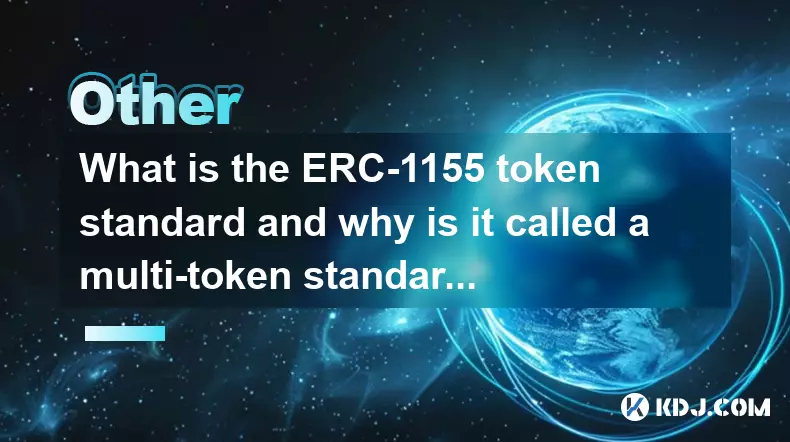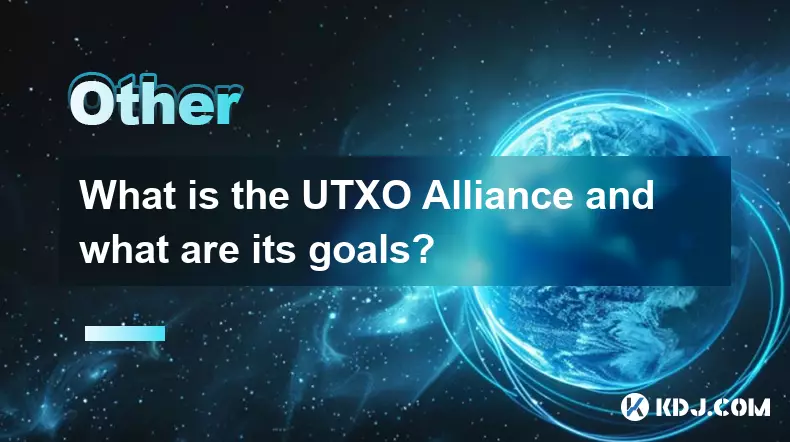-
 bitcoin
bitcoin $101752.865364 USD
-1.09% -
 ethereum
ethereum $3382.985899 USD
-1.38% -
 tether
tether $0.999658 USD
0.04% -
 xrp
xrp $2.272505 USD
-1.51% -
 bnb
bnb $989.089004 USD
0.14% -
 solana
solana $156.962612 USD
-3.08% -
 usd-coin
usd-coin $0.999776 USD
0.01% -
 tron
tron $0.290786 USD
-0.69% -
 dogecoin
dogecoin $0.174594 USD
-2.86% -
 cardano
cardano $0.560085 USD
-3.55% -
 hyperliquid
hyperliquid $40.023704 USD
-5.75% -
 chainlink
chainlink $15.324649 USD
-2.78% -
 bitcoin-cash
bitcoin-cash $493.576540 USD
-3.52% -
 zcash
zcash $571.320038 USD
-12.05% -
 stellar
stellar $0.280066 USD
-4.26%
What is the ERC-1155 token standard and why is it called a multi-token standard?
ERC-1155 revolutionizes Ethereum tokens by enabling fungible, non-fungible, and semi-fungible assets in one contract, reducing costs and boosting efficiency.
Nov 09, 2025 at 11:19 am

Understanding the ERC-1155 Token Standard
1. The ERC-1155 token standard is a revolutionary advancement in Ethereum-based token development, introduced by Enjin to address limitations found in earlier standards like ERC-20 and ERC-721. Unlike those predecessors, which are designed for either fungible or non-fungible tokens exclusively, ERC-1155 supports both within a single smart contract. This unified approach streamlines the creation and management of diverse digital assets.
2. At its core, ERC-1155 introduces a concept known as 'semi-fungibility,' where tokens can be either interchangeable or unique depending on their ID. Each token type is identified by a unique identifier, allowing multiple token types to coexist under one contract. This reduces deployment costs and simplifies interactions across decentralized applications.
3. Transactions in ERC-1155 are batched, meaning users can transfer multiple token types in a single transaction. This drastically lowers gas fees and increases network efficiency, especially important during high congestion periods on the Ethereum blockchain. Batch operations also enhance user experience by reducing wait times and complexity.
4. Smart contracts implementing ERC-1155 use a mapping system that tracks balances based on both account addresses and token IDs. This structure enables dynamic supply management, including minting and burning capabilities per token ID, offering developers greater control over asset lifecycles.
5. Security considerations were central during the design phase of ERC-1155. The standard includes built-in safeguards against reentrancy attacks and unauthorized transfers through careful function ordering and approval mechanisms. These features make it a preferred choice for platforms handling high-value digital collectibles and in-game items.
Why ERC-1155 Is Known as the Multi-Token Standard
1. The term 'multi-token' refers directly to ERC-1155’s ability to manage an unlimited number of distinct token types within a single deployed contract. This contrasts sharply with ERC-20, where each new token requires its own contract, and ERC-721, where each NFT typically resides in a separate instance or shared registry model.
2. By consolidating multiple token forms—fungible, non-fungible, and semi-fungible—into one interface, ERC-1155 eliminates redundancy. Developers no longer need to deploy and maintain several contracts for different asset classes, significantly cutting down operational overhead.
3. This consolidation also enhances interoperability between dApps, wallets, and exchanges, as they only need to integrate with one contract to support numerous token varieties. Marketplaces can list hundreds of item types from a game or metaverse platform without requiring individual integrations for each.
4. The multi-token nature allows for innovative economic models, such as issuing limited-edition NFTs alongside common currency tokens used for upgrades or crafting. These systems interact seamlessly due to shared logic and state within the same contract environment.
5. Because metadata and supply rules are defined at the token ID level rather than the contract level, flexibility increases dramatically. One ID might represent a million identical coins, while another represents a one-of-a-kind digital artwork—all governed by the same underlying codebase.
Use Cases Driving Adoption in the Crypto Space
1. Gaming ecosystems have become one of the primary adopters of ERC-1155, thanks to its efficient handling of in-game assets. Players can own weapons, skins, currencies, and characters—all represented as different token IDs—managed through a single contract.
2. Virtual worlds and metaverse platforms leverage ERC-1155 to issue land parcels, wearables, and utility tokens simultaneously. Users trade these assets across marketplaces with minimal friction, supported by standardized interfaces recognized by major wallet providers.
3. Decentralized finance (DeFi) protocols are beginning to explore hybrid collateral models using ERC-1155, where baskets of heterogeneous assets back loans or liquidity positions. This expands lending possibilities beyond uniform token types.
4. Event ticketing platforms utilize the standard to issue verifiable, transferable tickets with embedded rules—such as expiration dates or resale restrictions—coded directly into specific token IDs.
5. Content creators distribute tiered rewards to supporters, combining membership NFTs with redeemable credit tokens, all issued under one contract to ensure consistency and reduce administrative burden.
Frequently Asked Questions
What makes ERC-1155 more gas-efficient than ERC-721?ERC-1155 allows batch transfers of multiple token types in a single transaction, reducing the number of required calls to the blockchain. In contrast, transferring multiple ERC-721 tokens demands individual transactions or complex wrapper contracts, leading to higher cumulative gas costs.
Can an ERC-1155 token be both fungible and non-fungible at the same time?An individual ERC-1155 token ID defines whether it is fungible or not. For example, token ID 1 could represent a fungible currency with thousands of identical units, while token ID 2 could represent a unique avatar. The same contract handles both, but each ID behaves according to its designated properties.
How do wallets display ERC-1155 tokens?Modern crypto wallets like MetaMask and Trust Wallet support ERC-1155 by detecting the standard’s interface and rendering token balances grouped by ID. They show metadata such as name, image, and description fetched from URI links associated with each token ID.
Is ERC-1155 compatible with existing Ethereum infrastructure?Yes, ERC-1155 adheres to Ethereum’s execution environment and ABI standards, making it compatible with current tooling, explorers, and developer frameworks. While not all services natively supported it at launch, widespread adoption has led to broad integration across DeFi, NFT markets, and blockchain analytics platforms.
Disclaimer:info@kdj.com
The information provided is not trading advice. kdj.com does not assume any responsibility for any investments made based on the information provided in this article. Cryptocurrencies are highly volatile and it is highly recommended that you invest with caution after thorough research!
If you believe that the content used on this website infringes your copyright, please contact us immediately (info@kdj.com) and we will delete it promptly.
- Ripple (XRP) in 2026: Hold or Fold? A Look at XRP's Future and Emerging DeFi Alternatives
- 2025-11-08 18:35:01
- Zcash ZEC Coin Price Explosion: From Privacy Niche to Center Stage
- 2025-11-08 18:55:01
- Berachain Price Prediction: Navigating the Honeycomb Hype in Crypto
- 2025-11-08 18:55:01
- Arthur Hayes, Gold, and Bitcoin: A Modern Monetary Trinity?
- 2025-11-08 19:15:01
- Shiba Inu's Next Move: Navigating a Shifting Market
- 2025-11-08 19:20:01
- Pakistan's Crypto Crossroads: Balancing Opportunity with Asset-Backed Realities
- 2025-11-08 19:20:01
Related knowledge

What are intents in crypto and how do they change user interaction?
Nov 09,2025 at 09:00am
Understanding the Role of Decentralized Exchanges in Modern Crypto Trading1. Decentralized exchanges, commonly known as DEXs, have reshaped how trader...

What is restaking and how does it enhance economic security?
Nov 09,2025 at 11:40pm
Understanding Restaking in the Blockchain Ecosystem1. Restaking refers to the process where users who have already staked their tokens in a proof-of-s...

What is a cryptographic nonce and how is it used to prevent replay attacks?
Nov 08,2025 at 05:00pm
Understanding Cryptographic Nonces in Blockchain Systems1. A cryptographic nonce is a number used only once within a specific cryptographic communicat...

What are the trade-offs between liveness and safety in a consensus protocol?
Nov 09,2025 at 12:20pm
Understanding the Role of Liquidity Pools in Decentralized Finance1. Liquidity pools are foundational components within decentralized exchanges (DEXs)...

What is a call data in an Ethereum transaction and how is it used?
Nov 09,2025 at 01:59am
Understanding Call Data in Ethereum Transactions1. Call data refers to the information sent along with a transaction on the Ethereum network that spec...

What is the UTXO Alliance and what are its goals?
Nov 09,2025 at 01:39pm
Understanding the UTXO Alliance1. The UTXO Alliance is a collaborative initiative formed by prominent blockchain projects and developers who support t...

What are intents in crypto and how do they change user interaction?
Nov 09,2025 at 09:00am
Understanding the Role of Decentralized Exchanges in Modern Crypto Trading1. Decentralized exchanges, commonly known as DEXs, have reshaped how trader...

What is restaking and how does it enhance economic security?
Nov 09,2025 at 11:40pm
Understanding Restaking in the Blockchain Ecosystem1. Restaking refers to the process where users who have already staked their tokens in a proof-of-s...

What is a cryptographic nonce and how is it used to prevent replay attacks?
Nov 08,2025 at 05:00pm
Understanding Cryptographic Nonces in Blockchain Systems1. A cryptographic nonce is a number used only once within a specific cryptographic communicat...

What are the trade-offs between liveness and safety in a consensus protocol?
Nov 09,2025 at 12:20pm
Understanding the Role of Liquidity Pools in Decentralized Finance1. Liquidity pools are foundational components within decentralized exchanges (DEXs)...

What is a call data in an Ethereum transaction and how is it used?
Nov 09,2025 at 01:59am
Understanding Call Data in Ethereum Transactions1. Call data refers to the information sent along with a transaction on the Ethereum network that spec...

What is the UTXO Alliance and what are its goals?
Nov 09,2025 at 01:39pm
Understanding the UTXO Alliance1. The UTXO Alliance is a collaborative initiative formed by prominent blockchain projects and developers who support t...
See all articles





















![The Graph Price Prediction [GRT Crypto Price News Today] The Graph Price Prediction [GRT Crypto Price News Today]](/uploads/2025/11/07/cryptocurrencies-news/videos/690d4df44fe69_image_500_375.webp)




















































